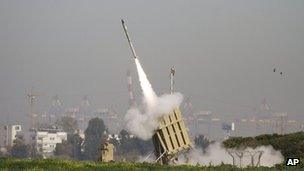US-Israel major joint exercise to test missile barrage scenario
- Published

More than 1,000 US troops are arriving in Israel for what promises to be the largest joint military exercise between the two countries ever held.
The focus is on ballistic missile defence. A variety of Israeli anti-ballistic missile systems will be incorporated into the exercise, including the Arrow and the much shorter range Iron Dome, which has proved itself countering missile fire from Gaza.
The US is deploying elements of Patriot air defence batteries in Israel, including the very latest versions of the system.
Overall some 3,500 US personnel are involved in the exercise; some in Israel; many at bases in Europe; as well as an Aegis radar-equipped warship in the Mediterranean Sea.
The exercise - dubbed Austere Challenge 2012 - is the sixth in a series of ballistic missile defence training manoeuvres held between the two countries.
It was due to be held some months ago but was postponed - seemingly at Israel's request; there was some unease at the time due to fears of an imminent Israeli strike against nuclear targets in Iran.
For whatever reason the US element actually deployed to Israel has been somewhat scaled down.
The exercise is a powerful reminder that for all the accusations from the Republicans during the US Presidential election campaign that the Obama Administration has been a less than steadfast supporter of Israel, the military relationship between the two countries has remained as strong as ever whilst President Barack Obama has been in the White House.
Two-front threat
This exercise, which will last for some two to three weeks, involves a whole series of simulated engagements with missiles being "fired" at Israel from two fronts. The purpose is to see how the various components of land and sea-based systems - radars, interceptors and so on - work together to counter this complex threat.
There will also be a smaller segment of the exercise involving live-firing.
US spokesmen are eager to stress that Austere Challenge is all about military teamwork - it is not related to the election cycle in either country nor, they say, to any perceived tensions in the region.
However, the immediate significance of the exercises is obvious. Talk of an Israeli strike against Iran may now be more muted, but it is clear that if this were ever to happen then one way Tehran might respond could be through the use of ballistic missiles.
These could either be launched from Iran itself, or alternatively Iran's ally, Hezbollah in Lebanon, could unleash its huge arsenal of missiles against Israel.
At the same time Jihadist groups in the Gaza Strip might step up their rocket fire into Israel, realising the two-front missile threat that this exercise simulates.
Austere Challenge also has important practical benefits for the US since Israel already deploys one of the most sophisticated anti-ballistic missile systems in the world.
To a large extent funded with US money, it is a kind of small-scale prototype of what the United States wants to roll out for its Nato allies.
So practicing how US early warning and communications systems can be integrated with Israeli and US ground-based missile interceptors will provide valuable lessons.
The maritime dimension - the Aegis-equipped US cruiser - is also important. Such ships, deployed in the Mediterranean, are due to play a prominent role in the proposed Nato ballistic missile defence system that is slowly being put together.
But for all the wizardry of the technology, questions still remain about the effectiveness of missile defence in actual combat.
Israel has had notable success with its Iron Dome system for example, but its defences have never come under sustained attack from the number of missiles that might be fired in a full-scale war.
The most obvious tactic for any enemy is to try to swamp the defensive systems with the volume of incoming fire.
To that extent the jury is still out on missile defence which can only be part of a much wider array of responses to the complex problem of ballistic missile attack.